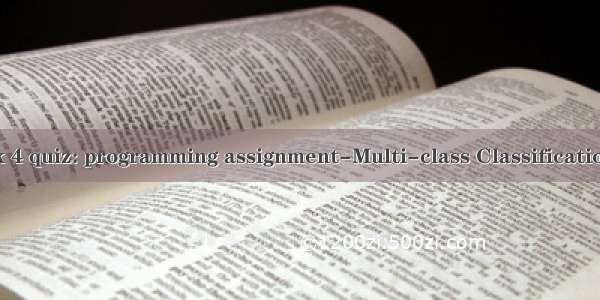
一、ex5.m
%% Machine Learning Online Class% Exercise 5 | Regularized Linear Regression and Bias-Variance%% Instructions% ------------% % This file contains code that helps you get started on the% exercise. You will need to complete the following functions:%%linearRegCostFunction.m%learningCurve.m%validationCurve.m%% For this exercise, you will not need to change any code in this file,% or any other files other than those mentioned above.%%% Initializationclear ; close all; clc%% =========== Part 1: Loading and Visualizing Data =============% We start the exercise by first loading and visualizing the dataset. % The following code will load the dataset into your environment and plot% the data.%% Load Training Datafprintf('Loading and Visualizing Data ...\n')% Load from ex5data1: % You will have X, y, Xval, yval, Xtest, ytest in your environmentload ('ex5data1.mat');% m = Number of examplesm = size(X, 1);% Plot training dataplot(X, y, 'rx', 'MarkerSize', 10, 'LineWidth', 1.5);xlabel('Change in water level (x)');ylabel('Water flowing out of the dam (y)');fprintf('Program paused. Press enter to continue.\n');pause;%% =========== Part 2: Regularized Linear Regression Cost =============% You should now implement the cost function for regularized linear % regression. %theta = [1 ; 1]; % 2*1J = linearRegCostFunction([ones(m, 1) X], y, theta, 1);fprintf(['Cost at theta = [1 ; 1]: %f '...'\n(this value should be about 303.993192)\n'], J);fprintf('Program paused. Press enter to continue.\n');pause;%% =========== Part 3: Regularized Linear Regression Gradient =============% You should now implement the gradient for regularized linear % regression.%theta = [1 ; 1];[J, grad] = linearRegCostFunction([ones(m, 1) X], y, theta, 1);fprintf(['Gradient at theta = [1 ; 1]: [%f; %f] '...'\n(this value should be about [-15.303016; 598.250744])\n'], ...grad(1), grad(2));fprintf('Program paused. Press enter to continue.\n');pause;%% =========== Part 4: Train Linear Regression =============% Once you have implemented the cost and gradient correctly, the% trainLinearReg function will use your cost function to train % regularized linear regression.% % Write Up Note: The data is non-linear, so this will not give a great % fit.%% Train linear regression with lambda = 0lambda = 0;[theta] = trainLinearReg([ones(m, 1) X], y, lambda);% Plot fit over the dataplot(X, y, 'rx', 'MarkerSize', 10, 'LineWidth', 1.5);xlabel('Change in water level (x)');ylabel('Water flowing out of the dam (y)');hold on;plot(X, [ones(m, 1) X]*theta, '--', 'LineWidth', 2)hold off;fprintf('Program paused. Press enter to continue.\n');pause;%% =========== Part 5: Learning Curve for Linear Regression =============% Next, you should implement the learningCurve function. %% Write Up Note: Since the model is underfitting the data, we expect to% see a graph with "high bias" -- slide 8 in ML-advice.pdf %lambda = 0;[error_train, error_val] = ...learningCurve([ones(m, 1) X], y, ...[ones(size(Xval, 1), 1) Xval], yval, ...lambda);plot(1:m, error_train, 1:m, error_val);title('Learning curve for linear regression')legend('Train', 'Cross Validation')xlabel('Number of training examples')ylabel('Error')axis([0 13 0 150])fprintf('# Training Examples\tTrain Error\tCross Validation Error\n');for i = 1:mfprintf(' \t%d\t\t%f\t%f\n', i, error_train(i), error_val(i));endfprintf('Program paused. Press enter to continue.\n');pause;%% =========== Part 6: Feature Mapping for Polynomial Regression =============% One solution to this is to use polynomial regression. You should now% complete polyFeatures to map each example into its powers%p = 8;% Map X onto Polynomial Features and NormalizeX_poly = polyFeatures(X, p);[X_poly, mu, sigma] = featureNormalize(X_poly); % NormalizeX_poly = [ones(m, 1), X_poly]; % Add Ones% Map X_poly_test and normalize (using mu and sigma)X_poly_test = polyFeatures(Xtest, p);X_poly_test = bsxfun(@minus, X_poly_test, mu);X_poly_test = bsxfun(@rdivide, X_poly_test, sigma);X_poly_test = [ones(size(X_poly_test, 1), 1), X_poly_test]; % Add Ones% Map X_poly_val and normalize (using mu and sigma)X_poly_val = polyFeatures(Xval, p);X_poly_val = bsxfun(@minus, X_poly_val, mu);X_poly_val = bsxfun(@rdivide, X_poly_val, sigma);X_poly_val = [ones(size(X_poly_val, 1), 1), X_poly_val]; % Add Onesfprintf('Normalized Training Example 1:\n');fprintf(' %f \n', X_poly(1, :));fprintf('\nProgram paused. Press enter to continue.\n');pause;%% =========== Part 7: Learning Curve for Polynomial Regression =============% Now, you will get to experiment with polynomial regression with multiple% values of lambda. The code below runs polynomial regression with % lambda = 0. You should try running the code with different values of% lambda to see how the fit and learning curve change.%lambda = 0;[theta] = trainLinearReg(X_poly, y, lambda);% Plot training data and fitfigure(1);plot(X, y, 'rx', 'MarkerSize', 10, 'LineWidth', 1.5);plotFit(min(X), max(X), mu, sigma, theta, p);xlabel('Change in water level (x)');ylabel('Water flowing out of the dam (y)');title (sprintf('Polynomial Regression Fit (lambda = %f)', lambda));figure(2);[error_train, error_val] = ...learningCurve(X_poly, y, X_poly_val, yval, lambda);plot(1:m, error_train, 1:m, error_val);title(sprintf('Polynomial Regression Learning Curve (lambda = %f)', lambda));xlabel('Number of training examples')ylabel('Error')axis([0 13 0 100])legend('Train', 'Cross Validation')fprintf('Polynomial Regression (lambda = %f)\n\n', lambda);fprintf('# Training Examples\tTrain Error\tCross Validation Error\n');for i = 1:mfprintf(' \t%d\t\t%f\t%f\n', i, error_train(i), error_val(i));endfprintf('Program paused. Press enter to continue.\n');pause;%% =========== Part 8: Validation for Selecting Lambda =============% You will now implement validationCurve to test various values of % lambda on a validation set. You will then use this to select the% "best" lambda value.%[lambda_vec, error_train, error_val] = ...validationCurve(X_poly, y, X_poly_val, yval);close all;plot(lambda_vec, error_train, lambda_vec, error_val);legend('Train', 'Cross Validation');xlabel('lambda');ylabel('Error');fprintf('lambda\t\tTrain Error\tValidation Error\n');for i = 1:length(lambda_vec)fprintf(' %f\t%f\t%f\n', ...lambda_vec(i), error_train(i), error_val(i));endfprintf('Program paused. Press enter to continue.\n');pause;
二、linearRegCostFunction.m
function [J, grad] = linearRegCostFunction(X, y, theta, lambda)%LINEARREGCOSTFUNCTION Compute cost and gradient for regularized linear %regression with multiple variables% [J, grad] = LINEARREGCOSTFUNCTION(X, y, theta, lambda) computes the % cost of using theta as the parameter for linear regression to fit the % data points in X and y. Returns the cost in J and the gradient in grad% Initialize some useful valuesm = length(y); % number of training examples % m% You need to return the following variables correctly J = 0; % 1*1grad = zeros(size(theta));% ====================== YOUR CODE HERE ======================% Instructions: Compute the cost and gradient of regularized linear %regression for a particular choice of theta.%%You should set J to the cost and grad to the gradient.%% linearRegh = X * theta; % m*(n+1) × (n+1)* -> m*J_part1 = sum((h-y).^2) /2 /m;theta2 = theta(2:end, :);J_part2 = sum(theta2.^2)/2/m*lambda;J = J_part1 + J_part2;% gradientgrad_ori = X' * (h-y) / m; %(n+1)*m × m*1 -> (n+1)*1grad(1) = grad_ori(1);grad(2:end) = grad_ori(2:end) + lambda/m*theta(2:end);% =========================================================================grad = grad(:);end
三、learningCurve.m
function [error_train, error_val] = ...learningCurve(X, y, Xval, yval, lambda)%LEARNINGCURVE Generates the train and cross validation set errors needed %to plot a learning curve% [error_train, error_val] = ...% LEARNINGCURVE(X, y, Xval, yval, lambda) returns the train and% cross validation set errors for a learning curve. In particular, % it returns two vectors of the same length - error_train and % error_val. Then, error_train(i) contains the training error for% i examples (and similarly for error_val(i)).%% In this function, you will compute the train and test errors for% dataset sizes from 1 up to m. In practice, when working with larger% datasets, you might want to do this in larger intervals.%% Number of training examplesm = size(X, 1); % m% You need to return these values correctlyerror_train = zeros(m, 1); % m*1error_val = zeros(m, 1); % m*1% ====================== YOUR CODE HERE ======================% Instructions: Fill in this function to return training errors in %error_train and the cross validation errors in error_val. %i.e., error_train(i) and %error_val(i) should give you the errors%obtained after training on i examples.%% Note: You should evaluate the training error on the first i training% examples (i.e., X(1:i, :) and y(1:i)).%% For the cross-validation error, you should instead evaluate on% the _entire_ cross validation set (Xval and yval).%% Note: If you are using your cost function (linearRegCostFunction)% to compute the training and cross validation error, you should % call the function with the lambda argument set to 0. % Do note that you will still need to use lambda when running% the training to obtain the theta parameters.%% Hint: You can loop over the examples with the following:%% for i = 1:m% % Compute train/cross validation errors using training examples % % X(1:i, :) and y(1:i), storing the result in % % error_train(i) and error_val(i)% ....% % end%% ---------------------- Sample Solution ----------------------for i = 1:mX_train = X(1:i, :);y_train = y(1:i);[theta] = trainLinearReg(X_train, y_train, lambda);lambda0 = 0;[J_train grad_train] = linearRegCostFunction(X_train, y_train, theta, lambda0);[J_val grad_val] = linearRegCostFunction(Xval, yval, theta, lambda0);error_train(i) = J_train;error_val(i) = J_val;end% -------------------------------------------------------------% =========================================================================end
四、validationCurve.m
function [lambda_vec, error_train, error_val] = ...validationCurve(X, y, Xval, yval)%VALIDATIONCURVE Generate the train and validation errors needed to%plot a validation curve that we can use to select lambda% [lambda_vec, error_train, error_val] = ...% VALIDATIONCURVE(X, y, Xval, yval) returns the train% and validation errors (in error_train, error_val)% for different values of lambda. You are given the training set (X,% y) and validation set (Xval, yval).%% Selected values of lambda (you should not change this)lambda_vec = [0 0.001 0.003 0.01 0.03 0.1 0.3 1 3 10]';% You need to return these variables correctly.error_train = zeros(length(lambda_vec), 1);error_val = zeros(length(lambda_vec), 1);% ====================== YOUR CODE HERE ======================% Instructions: Fill in this function to return training errors in %error_train and the validation errors in error_val. The %vector lambda_vec contains the different lambda parameters %to use for each calculation of the errors, i.e, %error_train(i), and error_val(i) should give %you the errors obtained after training with %lambda = lambda_vec(i)%% Note: You can loop over lambda_vec with the following:%% for i = 1:length(lambda_vec)% lambda = lambda_vec(i);% % Compute train / val errors when training linear % % regression with regularization parameter lambda% % You should store the result in error_train(i)% % and error_val(i)% ....% % end%%for i = 1:length(lambda_vec)lambda = lambda_vec(i);[theta] = trainLinearReg(X, y, lambda);lambda0 = 0;[J_train grad_train] = linearRegCostFunction(X, y, theta, lambda0);[J_val grad_val] = linearRegCostFunction(Xval, yval, theta, lambda0);error_train(i) = J_train;error_val(i) = J_val;end% =========================================================================end
五、polyFeatures.m
function [X_poly] = polyFeatures(X, p)%POLYFEATURES Maps X (1D vector) into the p-th power% [X_poly] = POLYFEATURES(X, p) takes a data matrix X (size m x 1) and% maps each example into its polynomial features where% X_poly(i, :) = [X(i) X(i).^2 X(i).^3 ... X(i).^p];%% You need to return the following variables correctly.X_poly = zeros(numel(X), p); % m*p% ====================== YOUR CODE HERE ======================% Instructions: Given a vector X, return a matrix X_poly where the p-th %column of X contains the values of X to the p-th power.%% m = numel(X);for i = 1:mfor j = 1:pX_poly(i, j) = X(i).^j;endend% =========================================================================end














